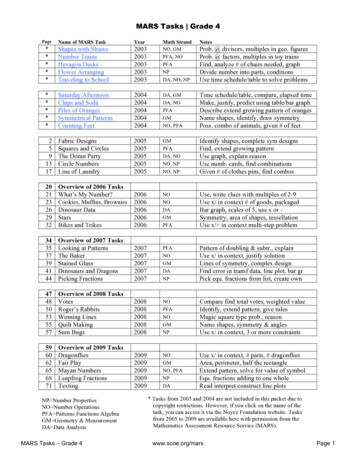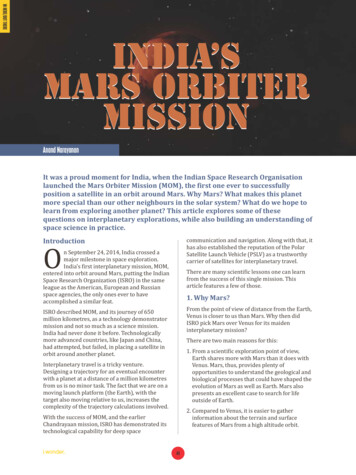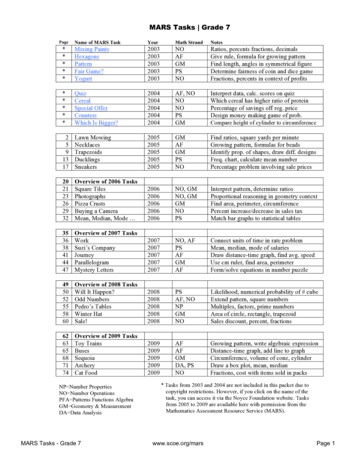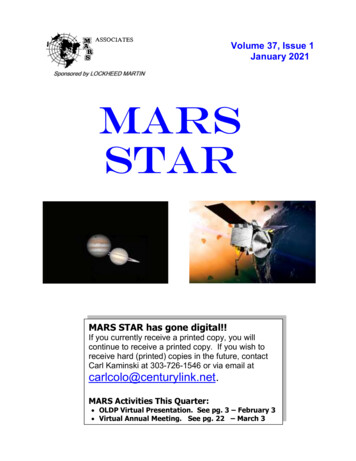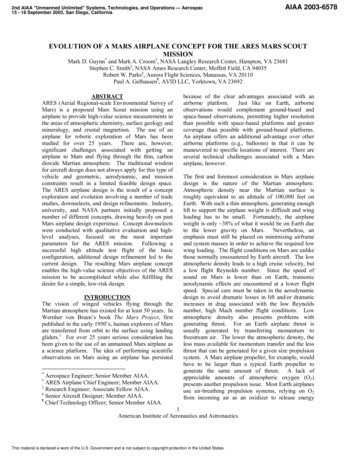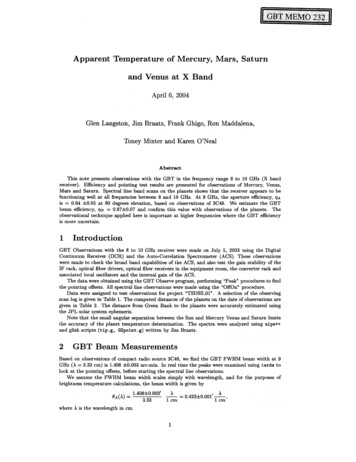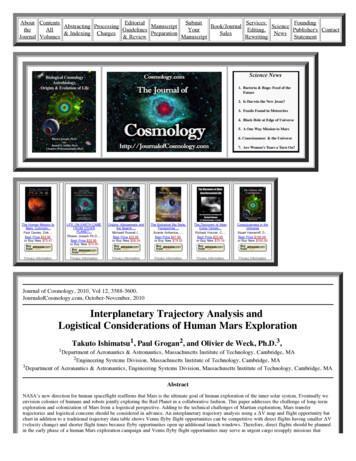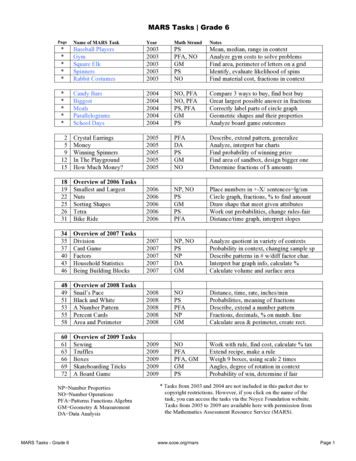
Transcription
MARS Tasks Grade 6PageName of MARS TaskYearMath StrandNotes*****Baseball PlayersGymSquare ElkSpinnersRabbit Costumes20032003200320032003PSPFA, NOGMPSNOMean, median, range in contextAnalyze gym costs to solve problemsFind area, perimeter of letters on a gridIdentify, evaluate likelihood of spinsFind material cost, fractions in context*****Candy BarsBiggestMealsParallelogramsSchool Days20042004200420042004NO, PFANO, PFAPS, PFAGMPSCompare 3 ways to buy, find best buyGreat largest possible answer in fractionsCorrectly label parts of circle graphGeometric shapes and their propertiesAnalyze board game outcomes2591215Crystal EarringsMoneyWinning SpinnersIn The PlaygroundHow Much Money?20052005200520052005PFADAPSGMNODescribe, extend pattern, generalizeAnalyze, interpret bar chartsFind probability of winning prizeFind area of sandbox, design bigger oneDetermine fractions of amounts181922252631Overview of 2006 TasksSmallest and LargestNutsSorting ShapesTetraBike Ride20062006200620062006NP, NOPSGMPSPFAPlace numbers in -X/ sentences lg/smCircle graph, fractions, % to find amountDraw shape that meet given attributesWork out probabilities, change rules-fairDistance/time graph, interpret slopes343537404346Overview of 2007 TasksDivisionCard GameFactorsHousehold StatisticsBeing Building Blocks20072007200720072007NP, NOPSNPDAGMAnalyze quotient in variety of contextsProbability in context, changing sample spDescribe patterns in # w/diff factor char.Interpret bar graph info, calculate %Calculate volume and surface area484951535558Overview of 2008 TasksSnail’s PaceBlack and WhiteA Number PatternPercent CardsArea and Perimeter20082008200820082008NOPSPFANPGMDistance, time, rate, inches/minProbabilities, meaning of fractionsDescribe, extend a number patternFractions, decimals, % on numb. lineCalculate area & perimeter, create rect.606163666972Overview of 2009 TasksSewingTrufflesBoxesSkateboarding TricksA Board Game20092009200920092009NOPFAPFA, GMGMPSWork with rule, find cost, calculate % taxExtend recipe, make a ruleWeigh 9 boxes, using scale 2 timesAngles, degree of rotation in contextProbability of win, determine if fairNP Number PropertiesNO Number OperationsPFA Patterns Functions AlgebraGM Geometry & MeasurementDA Data AnalysisMARS Tasks - Grade 6* Tasks from 2003 and 2004 are not included in this packet due tocopyright restrictions. However, if you click on the name of thetask, you can access the tasks via the Noyce Foundation website.Tasks from 2005 to 2009 are available here with permission fromthe Mathematics Assessment Resource Service (MARS).www.scoe.org/marsPage 1
6th gradeTask 1Crystal EarringsStudentTaskDescribe and extend a pattern of crystal earrings that is increasing in size.Make generalizations around this pattern.Core Idea3Algebra andFunctionsUnderstand relations and functions, analyze mathematical situations,and use models to solve problems involving quantity and change. Represent, analyze, and generalize a variety of relations andfunctions with tables, graphs, and words Model and solve contextualized problems using variousrepresentations such as graphs, tables, and equationsGrade 6 – 2005MARS Tasks - Grade 6pg.www.scoe.org/mars3Page 2
Grade Six – 2005MARS Tasks - Grade 6pg.www.scoe.org/mars4Page 3
Crystal EarringsGrade 6RubricThe core elements of performance required by this task are: to describe, extend, and make generalizations about a number patternBased on these, credit for specific aspects of performance should be assigned as follows1.Draws Pattern #4 correctly:pointssectionpoints112.Gives correct answer: 151Shows work such as:1 2 3, 3 3 6, 6 4 10, 10 5 153.4.12Completes table to show:Pattern #4 has 20 crystals.Pattern #5 has 30 crystals.11Shows work such as:Pattern #7 will be 1 2 3 4 5 6 7 28and 28 x 2 56, not 50or(accept 7 x 8)11or2Gives correct answer: 5631Total PointsGrade 6 – 2005MARS Tasks - Grade 628pg.www.scoe.org/mars5Page 4
6th gradeStudentTaskCore Idea5StatisticsTask 2MoneyAnalyze and interpret bar chart information to determine how muchmoney was spent by four children. Write a description to fit a fifth child’sbar chart.Select and use appropriate statistical methods to display, analyze,compare and interpret different data sets. Interpret data to answer questions about a situation Compare data sets using measures of center and spread tounderstand what each indicates about the data sets Communicate mathematical thinking clearly and coherently Use representations to interpret physical, social, and mathematicalphenomenaGrade 6 – 2005MARS Tasks - Grade 6pg.www.scoe.org/mars19Page 5
Grade Six – 2005MARS Tasks - Grade 6pg.www.scoe.org/mars20Page 6
Grade 6 – 2005MARS Tasks - Grade 6pg.www.scoe.org/mars21Page 7
MoneyGrade 6RubricThe core elements of performance required by this task are: interpret bar chartspointsBased on these, credit for specific aspects of performance should be assigned as followssectionpoints1. Gives correct answers:DannyChrisBenAliAll four answers correctPartial creditThree correct answersTwo correct answers3(2)3(1)2. a. Danny1b. Ali1Compares values on at least two graphs to show that the sum of Ali’s bars islarger than the other bars2Partial creditMakes a sensible verbal comment about the total amounts spent(1)43. Gives a reasonable description such as:“I spent more and more each week” or similar118Total PointsGrade Six – 2005MARS Tasks - Grade 6pg.www.scoe.org/mars22Page 8
6th gradeTask 3Winning SpinnersStudentTaskWork with two spinners to find the probability of winning a prize.Design two new spinners that will increase the likelihood of winning.Core Idea2ProbabilityDemonstrate understanding and the use of probability in problemsituations. Determine theoretical probabilities and use these to makepredictions about events Understand that the measure of the likelihood of an event can berepresented by a number from 0 to 1 Represent probabilities as ratios, proportions, decimals orpercents Represent the sample space for a given event in an organized way(e.g. table, diagram, organized list) Use representation to model and interpret mathematicalphenomenaGrade Six – 2005MARS Tasks - Grade 6pg.www.scoe.org/mars34Page 9
Grade 6 – 2005MARS Tasks - Grade 6pg.www.scoe.org/mars35Page 10
Winning SpinnersGrade 6RubricThe core elements of performance required by this task are: work with probabilityBased on these, credit for specific aspects of performance should be assigned as follows1. Fills in the table correctly: 8421715119891753sectionpoints2Spinner ASpinner Bpoints11 10139 7 611 7 5 413Partial creditNo more than 2 mistakesor no values, only “odd” or “even” given correctly.(1)22. Gives a correct answer: 4/16 1/4 or equivalentAccept correct decimals, percents and ’out of’.2ftPartial creditdenominator 16(1)23. Fills in spinners correctly:The even numbers split so there is one even number on one spinnerand two on the other (position of the numbers does not matter)2Gives a correct answer: 1/2 or equivalent2Gives an explanation or table to show a correct method.2Special case6Correctly uses their own numbers: maximum 2 pointsTotal PointsGrade Six – 2005MARS Tasks - Grade 610pg.www.scoe.org/mars36Page 11
6th gradeTask 4In The PlaygroundStudentTaskFind the area of a playground sandbox and make a new design thatwill measure twice the area of the first sandbox.Core Idea4Geometry andMeasurementAnalyze characteristics and properties of two-dimensionalgeometric shapes and apply the appropriate techniques, tools, andformulas to determine measurements. Develop, understand and use formulas to determine the area ofquadrilaterals Select and apply techniques and tools to accurately find lengthand area measures to appropriate levels of precisionGrade Six – 2005MARS Tasks - Grade 6pg.www.scoe.org/mars52Page 12
Grade 6 – 2005MARS Tasks - Grade 6pg.www.scoe.org/mars53Page 13
In the PlaygroundGrade 6RubricThe core elements of performance required by this task are: work with areasBased on these, credit for specific aspects of performance should be assigned as follows1.2.3.Gives correct answers: 24 square feet (Accept 80 square feet)56 square feetpoints112Draws a correct diagram:Rectangular area of sand, 48 square feet (12 squares)2Surrounded by a row of squares of “rubber matting”1Gives correct answer: their number of squares x 4(dependent on their diagram and following the one row rule)1ft80 or 72 (accept 120)4.sectionpoints31Gives a correct answer dependent on their diagram for question 2:12 and 42x1ftor 8 and 62or 2 and 24Total PointsGrade Six – 2005MARS Tasks - Grade 68pg.www.scoe.org/mars54Page 14
6th gradeTask 5How Much Money?StudentTaskWork with simple fractions to solve two money problems and userepresentations to organize and record the thinking.Core Idea1Number andOperationUnderstand number systems, the meanings of operations, and waysof representing numbers, relationships. And number systems. Understand fractions as parts of unit wholes Select appropriate methods and tools for computing with fractionsfrom among mental computations, estimation, calculators andpaper and pencil and apply selected methods Develop and analyze algorithms for operations on fractions anddevelop fluency in their use Create and use representations to organize, record, andcommunicate mathematical thinkingGrade 6 – 2005MARS Tasks - Grade 6pg.www.scoe.org/mars67Page 15
Grade Six – 2005MARS Tasks - Grade 6pg.www.scoe.org/mars68Page 16
How Much Money?Grade 6RubricThe core elements of performance required by this task are: work with simple fractions figure out a money problempointsBased on these, credit for specific aspects of performance should be assigned as follows1.Gives correct answer: 4 dollars and 80 cents1Finds 1/5 x 6.00 1.201Shows work such as: 6.00 - 1.20or4/5 x 6.002.sectionpoints121 dollar and 80 cents1ororone and a half times the incorrect answer that replaced 1.201 ftShows correct work such as:Works out that 1.20 represents (1 – 1/3) or 2/3 what Rachelle started withWorks out that Rachelle must have 0.60 1/2 of 1.20 left(adding the 1.20 .60 1.80 is credited in the answer)3113Total PointsGrade 6 – 2005MARS Tasks - Grade 6pg.www.scoe.org/mars669Page 17
Sixth GradeMars 2006Overview of ExamTask DescriptionsCore IdeaTaskSmallest and LargestNumber Properties andOperationsThis task asks students to analyze properties of numbers and operations to select numbersfrom a list to fit in equations to make the largest and smallest values. Successful studentsuse logic to pick numbers from a set to make the largest answer using addition, subtraction,multiplication and division. They could also use number properties to pick numbers from aset to make the smallest answer using addition and multiplication.NutsStatisticsThis task asks students to use clues to match quantities to a circle graph and usecalculations with fractions and percents to find amount of nuts. Successful students coulduse relational clues about most, least, twice as much, and fractional parts to identify andlabel data on a graph. Students could find one fourth of a quantity and use pictorial ornumerical reasoning to talk about 80% of a circle graph.Sorting ShapesGeometry andMeasurementThis task asks students to recognize and name shapes and their properties and draw a shapeto meet given attributes. Successful students could sort shapes by attributes such assymmetry and parallel sides. They could design shapes to meet more than one constraint.TetraProbabilityThis task asks students to complete scores in a table and work out probabilities from a tableof possible scores. Students analyze probabilities and make a change in game rules tomake a game fair. Successful students could find the total possibilities for a game usingtwo dice and write probabilities in terms of that total.Bike RideAlgebra and FunctionsThis task asks students to interpret a distance/time graph about a bike ride and use a graphto calculate and compare speeds. Successful students could read a time/distance graph anddetermine speeds and interpret slopes on the graph.1Grade Six – 2006(c) Noyce Foundation 2006. To reproduce this document, permission must be granted by the Noyce Foundation:info@noycefdn.org.MARS Tasks - Grade 6www.scoe.org/marsPage 18
Smallest and LargestThis problem gives you the chance to: choose numbers and operations to give largest and smallest results1. In this question, make up calculations with answers that are as large as possible.For each calculation, choose two different numbers from this list.12Copyright 2006 by Mathematics AssessmentResource Service. All rights reserved.12102050 – x Page 1Smallest and LargestTest 64Grade Six – 2006(c) Noyce Foundation 2006. To reproduce this document, permission must be granted by the Noyce Foundation:info@noycefdn.org.MARS Tasks - Grade 6www.scoe.org/marsPage 19
2. Now make the answers to your calculations as small as possible.For each calculation, choose two different numbers from this list.1212102050 – x 3. Explain how to choose numbers to make the answer to a division question assmall as possible.10Copyright 2006 by Mathematics AssessmentResource Service. All rights reserved.Page 2Smallest and LargestTest 65Grade Six – 2006(c) Noyce Foundation 2006. To reproduce this document, permission must be granted by the Noyce Foundation:info@noycefdn.org.MARS Tasks - Grade 6www.scoe.org/marsPage 20
Smallest and LargestRubricThe core elements of performance required by this task are: choose numbers and operations to give largest and smallest resultsBased on these, credit for specific aspects of performance should be assigned as follows1.Gives correct answer: 50 20 701Gives correct answer: 50 – 1/2 491/2 accept 49.51Gives correct answer: 50 x 20 100011Gives correct answer: 50 /2 1002.sectionpoints1Gives correct answer: 1/2 1 11/2 accept1.513.points411Gives correct answer: /2 – 50 -49 /2 accept -49.51Gives correct answer: 1/2 x 1 1/2 accept 0.51Gives correct answer: 1/2 50 1/100 accept 0.011Gives correct explanation such as:The first number must be the smallest of the list, and the second must be thelargest of the list.2Partial creditChoose a small number and divide by a large number.(1)Total Points42106Grade Six – 2006(c) Noyce Foundation 2006. To reproduce this document, permission must be granted by the Noyce Foundation:info@noycefdn.org.MARS Tasks - Grade 6www.scoe.org/marsPage 21
NutsThis problem gives you the chance to: work with interpretations of a circle graphThis circle graph shows the amounts of five different kinds of nuts grown in the U.S each year.Here are some facts about the nuts grown. Most of the nuts are Almonds A quarter of the nuts are Walnuts The least grown nuts are Macadamias There are about twice as many Pistachios as Macadamias grown The fifth type of nuts is HazelnutsCopyright 2006 by Mathematics AssessmentResource Service. All rights reserved.Page 3NutsTest 627Grade Six – 2006(c) Noyce Foundation 2006. To reproduce this document, permission must be granted by the Noyce Foundation:info@noycefdn.org.MARS Tasks - Grade 6www.scoe.org/marsPage 22
1. Write the correct kind of nut on each label.2. The total amount of all nuts grown is 956 thousand tons.What amount of walnuts is grown?thousand tonsShow your calculations.3. Iris says that 80% of all the nuts grown in the U.S. are almonds.Explain why Iris is wrong.10Copyright 2006 by Mathematics AssessmentResource Service. All rights reserved.Page 4Nuts Test 628Grade Six – 2006(c) Noyce Foundation 2006. To reproduce this document, permission must be granted by the Noyce Foundation:info@noycefdn.org.MARS Tasks - Grade 6www.scoe.org/marsPage 23
NutsRubricsectionpoints ipointsThe core elements of performance required by this task are: work with interpretations of a circle graphBased on these, credit for specific aspects of performance should be assigned as follows1.Gives correct answers, clockwise from s15W Gives correct answer: 239 thousand tonsork Shows work such as:the 956 4112.3.2Gives a correct and complete explanation, such as:Walnuts are 25%So that only leaves 75%orThe graph shows that a bit more than 50% (or a half) are almonds.or3Partial creditIncomplete quantitative explanation eg walnuts are 25%It doesn’t look like it on the graph.(2)(1)3Total Points31029Grade Six – 2006(c) Noyce Foundation 2006. To reproduce this document, permission must be granted by the Noyce Foundation:info@noycefdn.org.MARS Tasks - Grade 6www.scoe.org/marsPage 24
Sorting ShapesThis problem gives you the chance to: recognize and name shapes and their properties draw a shape to meet given conditionsHere are some two dimensional shapes drawn on square grid paper.ABCEDFGH1. What is the mathematical name of shape F?2. How many lines of symmetry does shape D have?3. Write the letter of each shape in the correct region of the diagram on the next page.The first one has been done for you.Sixth Grade – 2006Pg.44(c) Noyce Foundation 2006. To reproduce this document, permission must be granted by the Noyce Foundation:info@noycefdn.org.MARS Tasks - Grade 6www.scoe.org/marsPage 25
Shapes with at leastone line of symmetrywith no parallel sidesShapes with at leastone line of symmetrywith parallel sidesShapes with parallelsides with no linesof symmetryAAAll other shapes4. Draw another shape that could go into the shaded region.Copyright 2006 by Mathematics AssessmentResource Service. All rights reserved.Page 6Sorting ShapesTest 67Sixth Grade – 2006Pg.45(c) Noyce Foundation 2006. To reproduce this document, permission must be granted by the Noyce Foundation:info@noycefdn.org.MARS Tasks - Grade 6www.scoe.org/marsPage 26
Sorting ShapesRubricThe core elements of performance required by this task are: recognize and name shapes and their properties draw a shape to meet given conditionsBased on these, credit for specific aspects of performance should be assigned as followspoints1.Gives correct answer: hexagon12.Gives correct answer: 813.Completes the diagram.BGA DF Hsectionpoints11CE37 letters correct with no extrasPartial credit6 or 5 letters correct4 or 3 letters correct4.(2)(1)1 point for a shape with line(s) of symmetry,and 1 point for a shape with no parallel sides.31127Total PointsSixth Grade – 2006Pg.46(c) Noyce Foundation 2006. To reproduce this document, permission must be granted by the Noyce Foundation:info@noycefdn.org.MARS Tasks - Grade 6www.scoe.org/marsPage 27
TetraThis problem gives you the chance to: complete scores in a table of results work out probabilities from a table of possible scoresAnna and Bill play the game Tetra.In this game two four-sided dice numbered 1 to 4 are tossed.The numbers on the base of each dice are then multiplied together to get a score.When the score is even Anna gets a point.When the score is odd Bill gets a point.1. Complete this table of score results.Numberon base ofred dice4483362261134X1341164red23blue2Number on base of blue dice32. Explain why the probability of getting a score of 4 is 16 .3. Find the probability that Anna gets a point.Explain your work.Copyright 2006 by Mathematics AssessmentResource Service. All rights reserved.Page 7Sixth Grade – 2006TetraPg.Test 662(c) Noyce Foundation 2006. To reproduce this document, permission must be granted by the Noyce Foundation:info@noycefdn.org.MARS Tasks - Grade 6www.scoe.org/marsPage 28
4. This game is not fair.Suggest a change to the way that Anna and Bill get points that would make the game fair.6Copyright 2006 by Mathematics AssessmentResource Service. All rights reserved.Page 8Sixth Grade – 2006TetraPg.Test 663(c) Noyce Foundation 2006. To reproduce this document, permission must be granted by the Noyce Foundation:info@noycefdn.org.MARS Tasks - Grade 6www.scoe.org/marsPage 29
TetraRubricThe core elements of performance required by this task are: complete scores in a table of results work out probabilities from a table of possible scoresBased on these, credit for specific aspects of performance should be assigned as follows1.pointssectionpointsCompletes the table.6 correct results2Partial credit5, 4, or 3 correct results44833622114212X(1)12 169 1268343422.Gives a correct explanation, such as:There are 3 ways of getting a score of 4, and there are 16 possible outcomes.113.4.Gives correct answer: 12/16 or 3/4 (accept equivalent answers)1ftGives a correct explanation such as:12 of the results are even, and there are 16 possible outcomes.1ftSuggests a change such as:When the score is less than 5 Anna gets a point.When the score is more than 5 Bill gets a point.2116Total PointsSixth Grade – 2006Pg.64(c) Noyce Foundation 2006. To reproduce this document, permission must be granted by the Noyce Foundation:info@noycefdn.org.MARS Tasks - Grade 6www.scoe.org/marsPage 30
Bike RideThis problem gives you the chance to: interpret a distance/time graphSelina and Jack went for a bike ride today.They made this graph of their bike ride.2520Totalnumber :30a.m.12:00noon12:30p.m.1:00p.m.Time1. How many miles did they travel in all?miles2. How long did their bike ride take?hours3. When were they cycling the fastest?Explain your answer.Copyright 2006 by Mathematics AssessmentResource Service. All rights reserved.Page 9Sixth Grade – 2006Bike RidePg.Test 678(c) Noyce Foundation 2006. To reproduce this document, permission must be granted by the Noyce Foundation:info@noycefdn.org.MARS Tasks - Grade 6www.scoe.org/marsPage 31
4. What does the graph show that they did between 11:30 a.m. and 12 noon?Explain your answer.5. What was their speed between 12 noon and 1 p.m.?miles an hour7Copyright 2006 by Mathematics AssessmentResource Service. All rights reserved.Page 10Sixth Grade – 2006Bike RidePg.Test 679(c) Noyce Foundation 2006. To reproduce this document, permission must be granted by the Noyce Foundation:info@noycefdn.org.MARS Tasks - Grade 6www.scoe.org/marsPage 32
Bike RideRubricThe core elements of performance required by this task are: interpret a distance/time graphBased on these, credit for specific aspects of performance should be assigned as followspoints1.Gives correct answer: 2512.Gives correct answer: 313.Gives correct answer: from 10 a.m. to 10:30 a.m.1Gives correct comparative statement such as:The graph shows that they were cycling at 20 mph.Later they cycled at 10 mph and 5 mph.orIt is the steepest line4.sectionpoints1112Gives correct answer such as: They may have rested.1Gives correct explanation such as:For half an hour, their distance did not increase.125.Gives correct answer: 5117Total PointsSixth Grade – 2006Pg.80(c) Noyce Foundation 2006. To reproduce this document, permission must be granted by the Noyce Foundation:info@noycefdn.org.MARS Tasks - Grade 6www.scoe.org/marsPage 33
Sixth GradeCore IdeaMars 2007Overview of ExamTaskTask DescriptionsScoreDivisionRational NumbersThis task asks students to analyze the answer to a division problem in a variety ofcontexts. Students need to think about how to interpret the decimal and round itappropriately to answer the question for each situation. Students were also asked towrite a word problem that would fit a given calculation and pick the appropriateanswer to fit their own problem. Successful students could determine how to write thecorrect interpretation of the answer to each of the contexts from the same numericalanswer and understood how to round money.Card GameProbabilityThis task asks students to use probability in the context of picking cards, numbered 1to 10. Students needed to think about a changing sample space. Some cards were nolonger available after they had been drawn. Successful students could give anumerical value for each probability.FactorsNumber PropertiesThis task asks students to list factors of numbers and think about types of numberswith an odd number of factors or an equal amount of even and odd factors.Successful students used the factor list given to help them find and describe patternsin the numbers with different factor characteristics.Household StatisticsData AnalysisThis task asks students to use a bar graph about number of households and number ofchildren per household and record the information in a table. Students were alsoasked to interpret information from the graph and calculate percentages. Successfulstudents could think about total number of households, total number of children, ormean (or average) and match it to the correct computation.Building BlocksGeometry andMeasurementThis task asks students to calculate volume of rectangular prisms, given a picture ofthe object and its dimensions. Successful students could also calculate the surfacearea.th6 grade – 20071Copyright 2007 by Noyce FoundationResource Service. All rights reserved.MARS Tasks - Grade 6www.scoe.org/marsPage 34
DivisionThis problem gives you the chance to: relate a given division calculation to appropriate practical situationsWhen you calculate 100 6 using a calculator, the result is 16.6666667.This result can be used to give a sensible answer to all the following questions except one.1. Write down the sensible answers and find the question that cannot be answered using thisresult.a.How much does each person pay when 6 people share the cost of a meal costing 100?b. 100 children each need a pencil. Pencils are sold in packs of 6. How many packs areneeded?c. What is the cost per gram of shampoo costing 6 for 100 grams?d. How many CDs costing 6 each can be bought for 100?e. What is the average distance per day, to the nearest mile, travelled by a hiker on theAppalachian Trail, who covers 100 miles in 6 days?2. Write another question, together with its sensible answer, that can be answered using 100 6.7Copyright 2007 by Mathematics AssessmentResource Service. All rights reserved.MARS Tasks - Grade 6Page 4www.scoe.org/marsCard Game Test 6Page 35
Task 1: DivisionRubricThe core elements of performance required by this task are: relate a given division calculation to appropriate practical situationspointssectionpointsBased on these, credit for specific aspects of performance should be assigned as follows1a. Gives correct answer: 16.67 Accept 16.70, S16.75, 17.0011b. Gives correct answer: 1711c. Gives correct answer such as: ‘cannot be done using this result’11d. Gives correct answer: 1611e. Gives correct answer: 1712Writes an appropriate question.1Writes a sensible answer.1Total PointsCopyright 2007 by Mathematics AssessmentResource Service. All rights reserved.MARS Tasks - Grade 6Page 5www.scoe.org/mars527Card Game Test 6Page 36
Card GameThis problem gives you the chance to: figure out and explain probabilitiesMrs Jakeman is teaching her class about probability.She has ten cards, numbered 1 to 10.She mixes them up and stands them on a shelf so that the numbers do not show.Mrs. Jakeman turns the cards around one at a time.Students have to guess whether the next card will have a higher or a lower number than the one justturned.The first card turned is the number 3.31. Would you expect the next number to be higher than 3 or lower?Explain why you made this decision.The second card is number 10.3 102. What is the probability that the next card will be a higher number than 10?Explain how you know.Copyright 2007 by Mathematics AssessmentResource Service. All rights reserved.MARS Tasks - Grade 6Page 23www.scoe.org/marsCard Game Test 6Page 37
The third card is number 4.3 10 43. What is the probability that the next number is higher than 4?Show your work.The fourth card is number 7.3 10 474. What is the probability that the next number is lower than 7?Show your work.The fifth card is the number 1.3 10 471When the sixth card is turned the probability that the next card is higher is the same as theprobability that it is lower.5. What must the sixth card be?Explain how you figured it out.9Copyright 2007 by Mathematics AssessmentResource Service. All rights reserved.MARS Tasks - Grade 6Page 24www.scoe.org/marsCard Game Test 6Page 38
Task 2: Card GameRubricThe core elements of performance required by this task are: figure out and explain probabilitiespointssectionpointsand gives a correct explanation such as:There are more cards higher that 3 than lower than 3.11Gives a correct answer: 0 or impossible1Based on these, credit for specific aspects of performance should be assigned as follows1.2.3Gives a correct answer: higher2Gives a correct explanation such as:All the cards are lower than 10 so it is impossible for the next card to behigher.1Gives a correct answer: 5/7 or equivalent (71%)1Shows correct work such as:5,6,7,8,9 There are five higher numbers124.5.Gives a correct answer: 4/6 or equivalent (66.6%)1Shows correct work such as:1,2,5,6 There are four lower numbers1Gives a correct answer: 61Gives a correct explanation such as:The cards left are 2, 5, 6, 8 and 9The middle one of these is the 6 leaving two higher and two lower.12Total PointsCopyright 2007 by Mathematics AssessmentResource Service. All rights reserved.MARS Tasks - Grade 6Page 25www.scoe.org/mars29Card Game Test 6Page 39
FactorsThis problem gives you the chance to: work with factors of numbers up to 30A factor of a number divides into the number exactly.This table shows all the factors of most of the numbers up to 30.Number FactorsNumberof factorsNumberFactorsNumberof factors111161, 2, 4, 8, 16521, 22171, 17231, 32181, 2, 3, 6, 9, 18641, 2, 43191, 19251, 52201, 2, 4, 5, 10, 20661, 2, 3, 64211, 3, 7, 21471, 72221, 2, 11, 22481, 2, 4, 84231, 23291, 3, 93241, 2, 3, 4, 6, 8, 12, 248101, 2, 5, 104251, 5, 253111, 112261, 2, 13, 264121, 2, 3, 4, 6, 126274131, 132286141, 2, 7, 144292151, 3, 5, 154301, 2, 3, 5, 6, 10, 15, 308Copyright 2007 by Mathematics AssessmentResource Service. All rights reserved.M
MARS Tasks Grade 6 Page Name of MARS Task Year Math Strand Notes * Baseball Players 2003 PS Mean, median, range in context * Gym 2003 PFA, NO Analyze gym costs to solve problems * Square Elk 2003 GM Find area, perimeter of letters on a grid * Spinners 2003 PS Identify, evaluate likelihood of spins .
